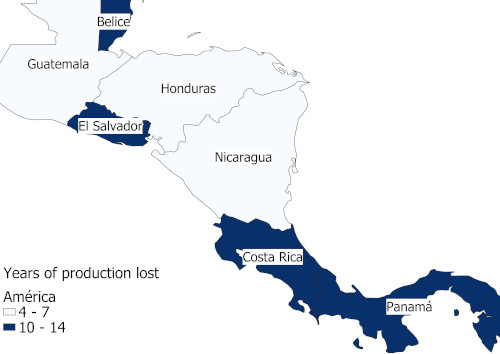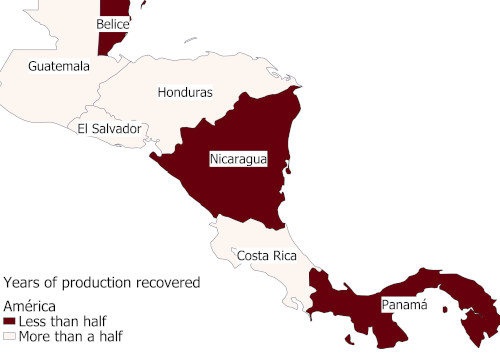Remittances and maquilas, the case of Central America
- blog de anegrete
- 4125 lecturas
Central America was the region most affected by the supply and demand crisis in the Americas. However, there was a significant disparity in the decline of each country. There are two groups, the first losing less than seven years of production, and the second losing more than ten years of production. They are Honduras, Nicaragua, Guatemala, Panama, El Salvador, Costa Rica, and Belize. We will show how external demand and remittances explain the disparities in decline and recovery.
The comparison between real GDP in the second quarter of 2020, at the start of social distancing measures in the Americas, with the quarterly GDP closer to its value, measures GDP loss in years. North America fell back on average 7.2 years during the second quarter of 2020, South America 8.3 and Central America, the most affected, 8.9. However, Honduras fell seven years, Nicaragua six and Guatemala four. The latter, together with Paraguay, decreased the least during the second quarter of 2020. In contrast, Panama lost ten, as did El Salvador, Belize 12 and Costa Rica 14. The latter, with Argentina, had the most significant output declines during the second quarter of 2020.

Central American economies have very close ties with the US and about half of their exports go to the US, except for Panama and Belize. Most of the products sent to the US economy are maquila textiles and animal and plant products. For Honduras, Nicaragua, Guatemala, El Salvador, and Costa Rica, in the second quarter of 2020, maquila exports fell by about 44%, while other shipments fell by only 12%. During the third quarter, the latter rose 35% and the others 10%. The slight increase in the pace of economic activity in the US boosted exports.
The arrival of Central Americans to the United States began to strengthen in the last 15 years. The flow of exiles is due to the region's ongoing political and economic instability. A socio-political crisis hit Nicaragua in 2018. Honduras, Costa Rica, and Panama experienced social unrest in 2019, and drug-related public security problems have characterised Guatemala, El Salvador, and Honduras.
Remittances, migrants' efforts to support their families, account for one-fifth of GDP in Honduras and one-tenth in Guatemala and Nicaragua. Although they declined in the second quarter of 2020 compared to 2019, they were sufficient to support falling exports, run current account surpluses, and provide families liquidity. Displaced persons work mainly in services. The end of confinement allowed them to return to their jobs so that, in the third quarter of 2020, remittances rebounded by 15 percent year-on-year.
During the second quarter of 2020, remittances cushioned the fall in export earnings, which prevented further years of production loss for Nicaragua, Honduras, and Guatemala. Remittance and export growth caused the latter to recover by more than half, while in Nicaragua, the increase in remittances was insufficient so that it rebounded by less than half.
In El Salvador, remittances were not large enough in the second quarter of 2020 to cushion the fall in exports, so it had a current account deficit. It impacted economic activity so that it lost more years than in the previous cases. The next quarter they recovered more than half of the production loss thanks to their remittances, which grew 17% annually. Costa Rica has no remittances because it has not expelled the labor force due to neither poverty nor insecurity. There was no counterbalance to the fall in exports. In more than half of the years lost to the next quarter, the improvement was due to maquila shipments.
Ecuador is Panama's leading trade partner and Belize's, Britain, and the USA. Both hard-hit countries lost ten and 14 years of GDP, respectively, due to the impact of Brexit and the Ecuadorian economic existing disaster. The re-establishment of international trade recovered Panama's revenues from its canal traffic. However, its return to normality is still slow; in December 2020, it was still four years behind its 2019 production. External demand for both recovers more slowly than the rest.

Migrant labour and the very close links with the US economy allowed for minor loss of production years and the recovery of more than half of Costa Rica, El Salvador, Guatemala, Honduras, and Nicaragua. On the contrary, Panama and Belize fell many years and recovered less than half. Their external demand is recovering more slowly. Finally, external demand and remittances explain both the downturn's disparities and their recovery, with no significant domestic fiscal or monetary impulse observed in any countries.